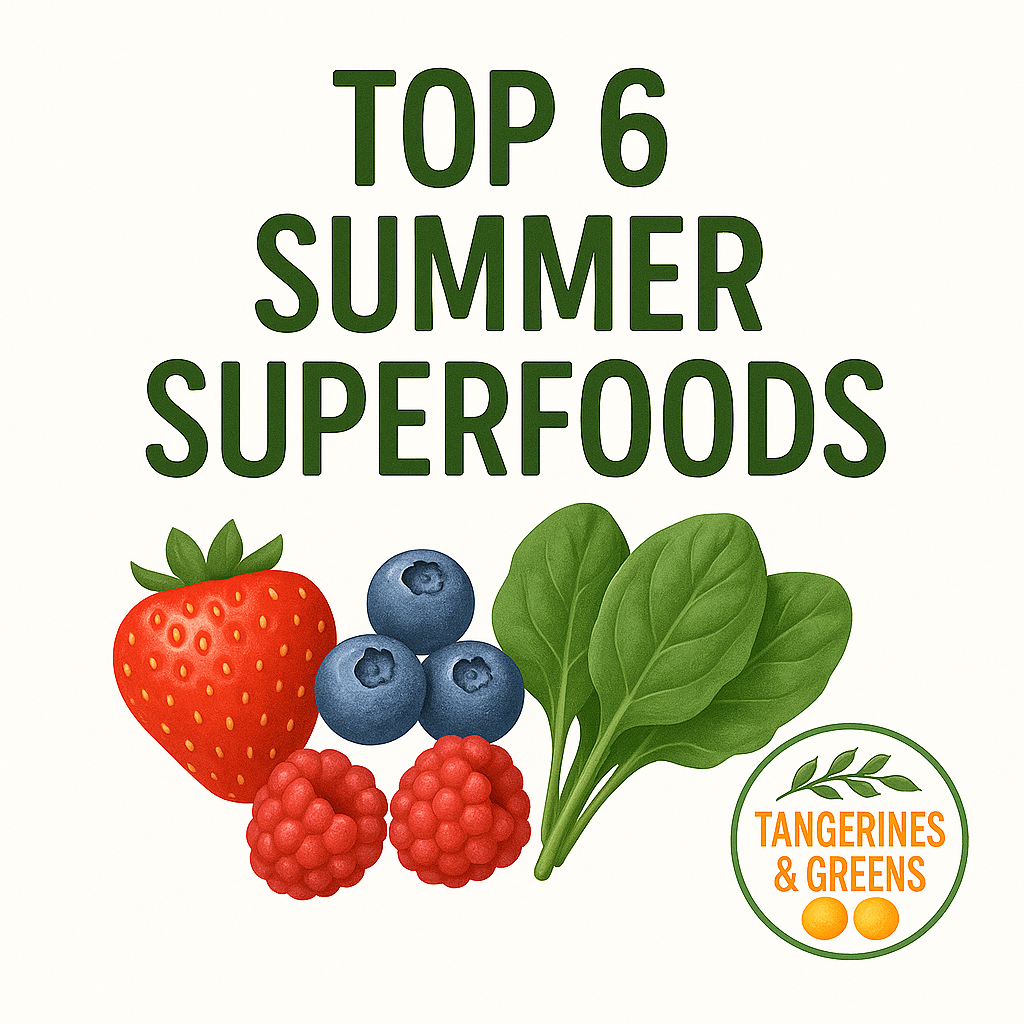Embrace the bounty of summer with these 6 nutrient-packed summer superfoods that will elevate your health and delight your taste buds!
Summer is just around the corner–for some of us it might already be here. Therefore, there’s no better time to start thinking about what foods we’ll be re-introducing into our everyday meals. Summer brings with it an abundance of vibrant, fresh produce that’s not just delicious but also at the peak of its nutritional value. Every restaurant has its own seasonal specials but there’s no reason you can’t have your own little corner of seasonal eating at home. Seasonal eating—choosing foods that are naturally grown and harvested during their optimal season—isn’t just a trendy food philosophy; it’s a practice backed by science that offers tremendous benefits for both your health and the environment. In this seasonal eating guide, we’ll explore the 6 summer superfoods that offer tremendous nutrition and impressive health benefits to help you make the most of this season’s harvest.
Why Superfoods Matter
Before diving into our summer superfood list, let’s talk about why seasonal eating should be part of your healthy lifestyle strategy. When you eat seasonally, you’re consuming foods at their nutritional prime. Fruits and vegetables harvested at peak ripeness contain higher levels of vitamins, minerals, and antioxidants compared to their out-of-season counterparts that may have traveled thousands of miles to reach your plate.
Research published in the Journal of Agricultural and Food Chemistry found that seasonal produce can contain up to 50% more phytonutrients than out-of-season alternatives. These plant compounds help fight inflammation, boost immunity, and protect against chronic diseases.
Plus, seasonal eating supports local farmers, reduces your carbon footprint (fewer transportation emissions!), and typically costs less since you’re buying produce when it’s most abundant. It’s a win-win for your health, wallet, and planet!
Summer Superfoods to Add to Your Plate
Berries: Nature’s Antioxidant Powerhouses
I don’t think anybody likes berries more than our daughter. She can eat strawberries and blueberries by the bucket full. While it doesn’t matter what time of the year it is for our sweet berry fiend, summer is berry season, after all, and these tiny fruits give us life and pack a mighty nutritional punch! Strawberries, blueberries, blackberries, and raspberries are all at their peak during summer months.
Nutritional benefits of seasonal berries:
- Loaded with vitamin C for immune support and skin health
- Rich in anthocyanins that fight oxidative stress and inflammation
- High in fiber for digestive health and sustained energy
- Low in calories but high in satisfaction factor!
If eating just plan ol berries isn’t your jam then I suggest grabbing a handful of mixed berries and add them to your morning granola or a refreshing smoothie. It doesn’t get any more superfood than the natural sweetness of berries on a hot summer day to help give you that nutritional kick. Juicier textures? Check. Flavor? Check. Daughter approved? Check.
Tomatoes: Lycopene Champions
Quick question about tomatoes. Why is it that you always have to add tomatoes to most salads? But I digress, Onto their superfood qualities! I don’t think there’s anything that quite compares to a sun-ripened summer tomato but an ice cold tea on a hot day, but not quite. These summer staples contain significantly more lycopene—a powerful antioxidant historically linked to heart health and cancer prevention—when they’re grown in season. However, be careful to mix them with foods that cancel out their cancer fighting power.
Why seasonal tomatoes are superior:
- Higher lycopene content (up to 3x more than off-season tomatoes)
- Better flavor profile due to higher sugar-to-acid ratio
- More vitamins A, C, and K
- Versatile for endless summer recipes
According to research from the American Journal of Clinical Nutrition, the lycopene increases when tomatoes are consumed with healthy fats, so drizzle some olive oil over your tomato salad for maximum benefits!
Leafy Greens: Summer Varieties
While many associate leafy greens with spring, summer has its own stellar lineup of nutritious greens. Look for arugula, Swiss chard, and heat-tolerant lettuces.
Summer greens nutritional profile:
- Excellent source of vitamin K for bone health
- Rich in folate for cell repair and reproduction
- Packed with lutein and zeaxanthin for eye health
- Alkalizing effect on the body
Summer greens tend to have slightly different flavor profiles than their spring counterparts—often with more pronounced peppery or bitter notes that add complexity to your meals. These stronger flavors signal the presence of beneficial plant compounds called glucosinolates, which support detoxification pathways in the body.
Stone Fruits: Summer’s Sweet Medicine
In our house, stone fruits are often overlooked for the berries bananas, and melons of the world but they really shouldn’t be! Stone fruits like peaches, nectarines, plums, and apricots reach their glorious peak during summer months. These juicy fruits aren’t just delicious treats—they’re also nutritional powerhouses.
Health benefits of seasonal stone fruits:
- Rich in vitamins A and C for immune function
- Contain potassium for healthy blood pressure
- Provide soluble fiber for heart health
- Offer natural phytochemicals with anti-inflammatory properties
Stone fruits are perfectly designed for summer nutrition—they’re hydrating, energizing, and provide quick nutrients when you’re active in hot weather. Their natural sugars are balanced with fiber for sustained energy without blood sugar spikes.
Cucumber: The Hydration Hero
Along with being 96% water, cucumbers are also a perfect snack for the little ones. They are perfect way to sneak in some greens into their meals! A bonus: their water component makes them perfect for summer hydration especially on those days when it’s impossible to breathe. But these cool, crisp vegetables offer more than just water.
Why seasonal cucumbers deserve superfood status:
- Natural electrolytes including potassium and magnesium
- Silica for skin, hair, and nail health
- Anti-inflammatory compounds that help reduce puffiness
- Cooling effect on the body during hot weather
In-season summer cucumbers have thinner, more tender skins and fewer seeds than their greenhouse-grown counterparts. They make excellent additions to salads, smoothies, or simply enjoyed with a sprinkle of sea salt as a refreshing snack.
Peppers: Vitamin C Superstars
While peppers aren’t my favorite, I can’t deny their summer superfood bonafides. Bell peppers and their spicier cousins reach their colorful, nutritional peak during summer months. A single red bell pepper contains more vitamin C than an orange!
Nutritional highlights of seasonal peppers:
- Exceptional vitamin C content (particularly in red varieties)
- Rich in carotenoids for eye and skin health
- Good source of B vitamins for energy
- Contains capsaicin (in hot varieties) with metabolism-boosting properties
Summer peppers are noticeably juicier, with thicker flesh and more complex flavors than out-of-season versions. They’re versatile ingredients that shine in everything from salads to grilled dishes.
Creating Your Seasonal Eating Plan
Now that you know some of the nutritional superstars of summer, how do you incorporate seasonal eating into your lifestyle? Here are some practical tips:
- Visit farmers markets – There’s no better place to discover what’s truly in season in your area. Plus, you can talk directly with farmers about their growing practices. (Alternatively, you can try your hand at growing your own)
- Learn simple preservation methods – Freezing berries, making tomato sauce, or pickling vegetables lets you extend the nutritional benefits of summer produce.
- Plan meals around what’s in season – Start with the produce that’s abundant, then build your meal plans around these seasonal stars.
Seasonal eating isn’t about perfection—it’s about making mindful choices that benefit your health when possible. Even incorporating just a few seasonal superfoods into your weekly routine can make a significant difference in your nutritional intake.
The Sustainable Impact of Seasonal Eating
Beyond personal health benefits, seasonal eating has profound environmental implications. Studies from the Journal of Cleaner Production show that out-of-season produce can generate up to 10 times more carbon emissions than locally-grown seasonal alternatives.
When you choose seasonal foods, you’re naturally selecting options that required fewer resources to produce—less water, energy, transportation fuel, and often fewer pesticides. Your food choices become a powerful form of environmental activism three times a day!
Embracing Summer’s Nutritional Abundance
Summer’s nutritional offerings are particularly abundant—bursting with hydrating, energizing foods that perfectly support our more active warm-weather lifestyles. You won’t regret having juicy berries or a tomato and cucumber salad on those particularly excruciating hot summer days.
By making seasonal superfoods the foundation of your summer nutrition plan, you’ll not only enjoy more flavorful meals but also maximize your nutrient intake while minimizing your environmental impact. That’s the essence of truly nourishing, sustainable nutrition.
So next time you’re planning meals or grocery shopping, think seasonally first. Your body, taste buds, wallet, and planet will all thank you for embracing summer’s spectacular superfood lineup!
What summer superfood are you most excited to incorporate into your meals this season? Share your favorite seasonal recipes and discoveries in the comments below!






0 Comments